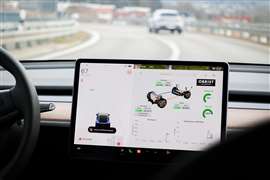Obrist Group supports revisiting range-extended electric vehicles
15 November 2024
 Hyperhybrid system instrument panel (Photo: Obrist Group)
Hyperhybrid system instrument panel (Photo: Obrist Group)
The Obrist Group, which has locations in both Austria and Germany, is dedicated to the development and implementation of technologies intended to reduce the environmental impact of energy production.
Founded by Frank Obrist, the group has an extended history of working in the power sector; Obrist’s first professional role involved working with Felix Wankel, developer of the Wankel engine. Instead of pistons, these use an eccentric rotary system to compress the fuel/air mix and deliver power at the crank.
The engines have been used by a series of OEMs. Most famously the tech featured in various Mazda models, including the RX series of sports cars. But others have also employed the engines, including NSU, the company which went on to become Audi.
Moving forward to the present day, Frank Obrist has argued that “the question of a ban on [internal] combustion engines in the EU is being discussed in far too many black and white terms”. Essentially, he believes that with the correct technology application there is still space for the IC engine in a low-carbon world.
One such low-carbon IC engine application put forward by Obrist is the ‘Hyperhybrid’. Instead of a powertrain driven exclusively by an IC engine, this is a range-extended electric vehicle (REEV) which employs the engine only to generate current that powers electric motors.
“This intelligent combination could become a lifeline for the European automotive industry because it is environmentally friendly on the one hand and fulfils consumers’ wishes for driving without range anxiety and long charging times on the other,” said Obrist.
A similar REEV powertrain was developed by General Motors and featured in the Chevrolet Volt/Opel Ampera. But these saloon/sedan cars did not sell well for a variety of reasons. Beyond the market preference for SUVs over four-door vehicles and a lack of customer understanding as to how the powertrain worked, the system itself was poorly executed.
Obrist, though, believes that the time has come to revisit this solution as it offers a series of advantages. As the IC engine is only used as a generator, it can have a smaller displacement than one used to directly power the wheels. And, as the engine only generates current, it can operate at the most efficient speed, reducing related emissions.
The system delivers some favourable numbers; prototypes tested by the Obrist Group have returned fuel economy figures of 1.5 litres of petrol or 3.3 litres of methanol per 100 kilometres.
But there’s more. According to the Obrist Group, comparisons of the Hyperhybrid range-extender powertrain to a pure battery-electric equivalent would see an 85% reduction in CO2 simply due to the reduced size of the battery pack. The smaller pack could also help to cut the retail cost of the vehicle in comparison to battery-electric models.
A Hyperhybrid powertrain would have a range of about 1,000 kilometres and would be easy to refuel. But additionally, fitted with a 20 to 30 kWh battery pack the vehicle could return an electric-only range of approximately 80 km, sufficient for most daily journeys.
In all the above, the REEV powertrain is demonstrated as applied to a passenger car. But at least in theory, there should be no blocks to applying the same tech to a light commercial vehicle. With further development, it’s possible that a REEV system could go on to replace most of the battery packs in a pure electric heavy-goods vehicle.
Commenting on the Hyperhybrid, Thorsten Rixmann, head of Marketing at the Obrist Group, said: “We need cars made in Europe that are so attractive that there is sufficient demand for them on a large scale without purchase premiums or other state subsidy programs. This is obviously not the case with purely electric cars, as the imbalance in the car industry unfortunately proves all too clearly.”
With these benefits in mind, the Obrist Group is petitioning European policymakers to reconsider this ‘best of both worlds’ solution.
Rixmann: “While [the Hyperhybrid] is more complex in practice, it represents a viable long-term strategy for the European auto industry, especially considering the current hesitancy around fully battery-electric cars - assuming policymakers support this direction.”
CONTÁCTESE CON EL EQUIPO





